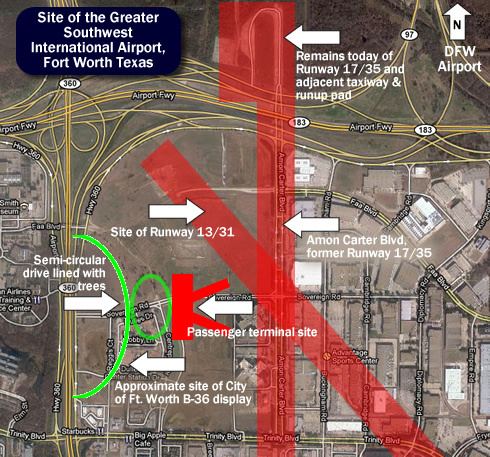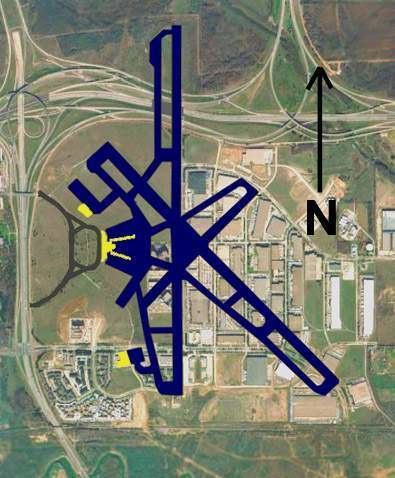Airport type Public Code GSW Opened 25 April 1953 | Owner City of Fort Worth Elevation AMSL 568 ft / 173 m Elevation 173 m | |
 | ||
Operator Allied Fueling Company / Allied Service Company Closed January 13, 1974 (1974-01-13) | ||
November 1959 scenes of greater southwest international airport amon carter field at fort worth
Greater Southwest International Airport (IATA: GSW, ICAO: KGSW), originally Amon Carter Field, is a now closed commercial airport serving Fort Worth, Texas, from 1953 until 1974. Dallas-Fort Worth International Airport (DFW) opened in 1974 a few miles north of the airport as the planned replacement for both Greater Southwest and Dallas Love Field (DAL) as the single main airport for all scheduled airline flights for the Dallas-Fort Worth Metroplex, although Love Field survives with Southwest Airlines being the major carrier there. The area is now a commercial/light-industrial park serving DFW International, centered along Amon Carter Boulevard, which was originally constructed from the old airport's north-south runway.
Contents
- November 1959 scenes of greater southwest international airport amon carter field at fort worth
- Early history
- Airline service
- Decline and closure
- After closure
- References

Early history

Starting in the 1920s, the city of Fort Worth planned to create a regional airport on the eastern end of Tarrant County, equidistant from the centers of Dallas and Fort Worth, to serve the entire metropolitan area. The city of Dallas initially had no interest in the plan, but began to consider it during the Great Depression as a means of easing the financial burden on the city government. Work on the site began in the mid-1930s. Dallas and Fort Worth planned to obtain Works Progress Administration funding for the terminal construction, until Dallas abruptly withdrew from the project when it was found that the terminal would be located one mile closer to Fort Worth. The unfinished airport appeared as an auxiliary airfield on 1940s sectional charts, under the names Arlington Airport and Midway Field.

After World War II, Fort Worth resumed work on the airfield, having decided to move its primary airline traffic from Meacham Field to the new facility. The airport, dubbed Amon Carter Field (airport code "ACF") in 1950, opened in the spring of 1953. Fort Worth annexed a finger of land to the east, extending the city limits to encompass the new site.
Airline service

American, Braniff International, Central, Continental, Delta, Eastern, Frontier, and Trans-Texas Airways operated from the airport, which had three paved runways and a two-pier terminal with 17 gates. The April 1957 OAG shows 97 scheduled departures a day Tuesday to Thursday, more than half to Dallas. American Airlines had 30, Braniff 22, Trans-Texas 19, Continental 13, Delta 7, and Central 6. On December 20, 1959, jet service began with American Airlines Boeing 707 flights to Los Angeles. By 1962, Delta Air Lines was operating Convair 880 jet nonstops to Los Angeles and New Orleans.

In 1960 the airport was renamed Greater Southwest International Airport (airport code "GSW") in a failed attempt to attract passengers. In the same year the city of Fort Worth purchased the airport. By the mid 1960s, Braniff was operating BAC One-Elevens and Lockheed L-188 Electras while Continental was flying Douglas DC-9-10s and Vickers Viscounts to the airport. In 1967 American and Eastern were operating Boeing 727s from the airfield; American's 727 flew direct to Los Angeles LAX via El Paso while Eastern's 727 flew Fort Worth-Dallas Love Field-New Orleans-Tampa-Orlando.
For several years the airport was home to a Convair B-36 Peacemaker City of Fort Worth, the last of its type, on display near the passenger terminal. After the airport's closure, the B-36 was removed, eventually joining the collection at the Pima Air and Space Museum in Tucson, Arizona.
Decline and closure
The airport never reached capacity and saw its traffic dwindle while traffic at nearby Love Field in Dallas continued to grow. In 1964, the Federal Aviation Agency, tired of funding separate airports for Dallas and Fort Worth, announced that it would no longer support both. The Civil Aeronautics Board ordered the two cities to finally come up with a plan for a regional airport, and in 1965 a parcel of land north of Greater Southwest was selected for Dallas Fort Worth International Airport. As traffic boomed at Dallas-Love Field it slumped at Fort Worth as most carriers tried to pull out; by 1967, the only scheduled flights remaining were a single American flight to Los Angeles and a small number of intrastate flights. American was the last scheduled carrier at GSW, ceasing service in 1969.
The airport remained operational as a training and maintenance facility for American, Braniff and Delta, who used GSW's ILS facilities for pilot training. It was also used for general aviation and aircraft storage. During this period, on May 30, 1972, Delta Air Lines Flight 9570 crashed at Greater Southwest International Airport while performing "touch and go" training landings. The National Transportation Safety Board determined that wake turbulence from another training flight, an American Airlines McDonnell Douglas DC-10, had caused the Delta Douglas DC-9-10 to lose control as it neared touchdown. As this was a training flight, only four people were on board flight 9570 at the time of the crash: three crew and an FAA operations inspector. All were killed.
When Dallas-Fort Worth International opened in January 1974, the FAA closed the runways at Greater Southwest as a safety precaution.
After closure
The airfield was sold to a private real estate developer in 1979, and the terminal building was demolished in 1980 after being vacant for a decade. Following the closure of the airport, Runway 17/35 became Amon Carter Boulevard for several years before it was torn up and replaced with an actual street. As of 2014 a small section of the taxiway and run-up area of Runway 17 still exists at the northern end of Amon Carter Boulevard, on the north side of State Highway 183. Remnants of the terminal driveway also remain visible to the east of State Highway 360.
American Airlines expanded its headquarters to new buildings on the airport site during the 1980s and 1990s (the airline's former hangar had remained in use as a reservations center for several years before it was demolished). The airport's IATA airport code, GSW, is still in use by the American Airlines Flight Academy, which sits across State Highway 360 from the airport site.
